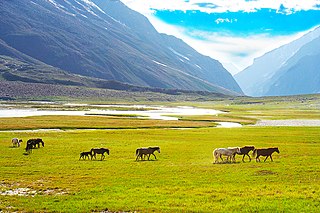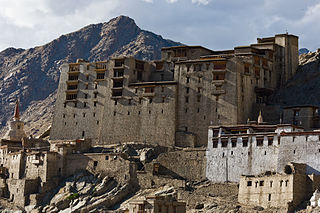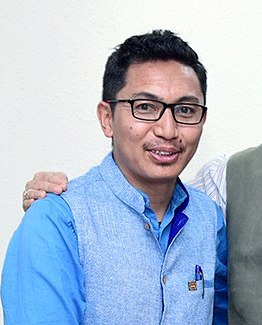| Jamyang Namgyal | |
|---|---|
| Gyalpo of Ladakh | |
| Reign | 1595 - 1616 CE |
| Predecessor | Namgyal Gonpo |
| Successor | Sengge Namgyal |
| House | Namgyal dynasty of Ladakh |
| Father | Tsewang Namgyal |
| Religion | Buddhism |
Jamyang Namgyal (Ladakhi: འཇམ་དབྱངས་རྣམ་རྒྱལ, Wylie: ʻjam dbyangs rnam rgyal, died 1616) was a 17th-century Namgyal dynasty king (gyalpo) of Ladakh, India from 1595 till his death in 1616 AD. He was succeeded by his son Sengge Namgyal in the year 1616 AD.
Jamyang Namgyal was born to and was the eldest son of Tsewang Namgyal who was the king of Ladakh from 1575 to 1595 AD. [1] [2] Jamyang Namgyal took the reign of the Namgyal dynasty of Ladakh in 1595 AD and continued to be in power until his death in 1616 AD. [2] [3] [4] Jamyang Namgyal was married to Gyal Khatun, the daughter of Ali Sher Khan Anchan who attacked Ladakh and imprisoned Namgyal. [5]
Jamyang Namgyal during his reign decided to support the Sultan of Chigtan and to capture Skardu. Namgyal's army was crossing the mountain passes towards Purig during the winter season where his troops disappeared due to violent storm. Ali Sher Khan Anchan's well trained army attacked Namgyal's army on the way and held them there until all the passes and valleys were blocked with snow; compelling Namgyal to surrender. Namgyal was imprisoned by Ali Sher Khan in Skardu. Sher Khann then attacked Ladakh, took control of the place, destroyed historical monuments and records. [3] After returning to Skardu, Sher Khan asked Jamyang Namgyal to marry his daughter Gyal Khatun in exchange of his release. Namgyal married Ali's daughter and returned to Ladakh. [5]

Ladakh is a region administered by India as a union territory and constitutes an eastern portion of the larger Kashmir region that has been the subject of a dispute between India and Pakistan since 1947 and India and China since 1959. Ladakh is bordered by the Tibet Autonomous Region to the east, the Indian state of Himachal Pradesh to the south, both the Indian-administered union territory of Jammu and Kashmir and the Pakistan-administered Gilgit-Baltistan to the west, and the southwest corner of Xinjiang across the Karakoram Pass in the far north. It extends from the Siachen Glacier in the Karakoram range to the north to the main Great Himalayas to the south. The eastern end, consisting of the uninhabited Aksai Chin plains, is claimed by the Indian Government as part of Ladakh, and has been under Chinese control since 1962.

Hulegu Khan, also known as Hülegü or Hulagu, was a Mongol ruler who conquered much of Western Asia. Son of Tolui and the Keraite princess Sorghaghtani Beki, he was a grandson of Genghis Khan and brother of Ariq Böke, Möngke Khan, and Kublai Khan.

Baltistan also known as Baltiyul or Little Tibet, is a mountainous region in the Pakistani-administered territory of Gilgit–Baltistan. It is located near the Karakoram and borders Gilgit to the west, China's Xinjiang to the north, Indian-administered Ladakh to the southeast, and the Indian-administered Kashmir Valley to the southwest. The average altitude of the region is over 3,350 metres (10,990 ft). Baltistan is largely administered under the Baltistan Division.

Kargil district is a district in Indian-administered Ladakh in the disputed Kashmir-region. It is one of the two districts comprising the Indian-administered union territory of Ladakh. The district headquarters are in the city of Kargil. The district is bounded by the Indian-administered union territory of Jammu and Kashmir to the west, the Pakistani-administered administrative territory of Gilgit–Baltistan to the north, Ladakh's Leh district to the east, and the Indian state of Himachal Pradesh to the south. Encompassing three historical regions known as Purig, Dras and Zanskar, the district lies to the northeast of the Great Himalayas and encompasses the majority of the Zanskar Range. Its population inhabits the river valleys of the Dras, Suru, Wakha Rong, and Zanskar.

Skardu is a city located in Gilgit-Baltistan, in Pakistan. Skardu serves as the capital of Skardu District and the Baltistan Division. It is situated at an average elevation of nearly 2,500 metres above sea level in the Skardu Valley, at the confluence of the Indus and Shigar rivers. The city is an important gateway to the eight-thousanders of the nearby Karakoram mountain range. The Indus River running through the region separates the Karakoram from the Ladakh Range.

Ladakh has a long history with evidence of human settlement from as back as 9000 b.c. It has been a crossroad of high Asia for thousands of years and has seen many cultures, empires and technologies born in its neighbours. As a result of these developments Ladakh has imported many traditions and culture from its neighbours and combining them all gave rise to a unique tradition and culture of its own.

The Suru Valley is a valley in the Kargil District in the Union Territory of Ladakh, India. It is drained by the Suru River, a tributary of the Indus River. The valley's most significant town is Sankoo.

The Namgyal dynasty was a dynasty whose rulers were the monarchs of the former kingdom of Ladakh that lasted from 1460 to 1842 and were titled the Gyalpo of Ladakh. The Namgyal dynasty succeeded the first dynasty of Maryul and had several conflicts with the neighboring Mughal Empire and various dynasties of Tibet, including the Tibet–Ladakh–Mughal War. The dynasty eventually fell to the Sikh Empire and Dogras of Jammu. Most of its known history is written in the Ladakh Chronicles.

Sengge Namgyal was a 17th-century Namgyal dynasty King of Ladakh, from 1616 to his death in 1642. A Buddhist, he was noted for his immense work in building monasteries, palaces and shrines in Ladakh and is known as the "Lion King".

Brigadier Sher Jung Thapa MVC was a military officer of the Jammu and Kashmir State Forces and later the Indian Army. Revered as the Hero of Skardu, he was a recipient of the Indian Army's second highest gallantry award, the Maha Vir Chakra (MVC).
Gilgit-Baltistan is an administrative territory of Pakistan that borders the province of Khyber Pakhtunkhwa to the west, Azad Kashmir to the southwest, Wakhan Corridor of Afghanistan to the northwest, the Xinjiang Uyghur Autonomous Region of China to the north, and the Indian-administered region of Jammu and Kashmir to the south and south-east.

Ali Sher Khan Anchan was a famous Balti king. He was a Maqpon dynasty king who unified Baltistan and expanded its frontiers to Ladakh and western Tibet in the east, and in the west to the borders of Ghizar and Chitral.

Galdan Namchot is a festival celebrated in Tibet, Nepal, Mongolia and many regions of Himalaya, particularly in Ladakh, India. It is to commemorate the birth as well as parinirvana (death) and the Buddhahood of Je Tsongkhapa, a famous Scholar/teacher of Tibetan Buddhism whose activities led to the formation of the Gelug school of Tibetan Buddhism. Galdan Namchot also marks the beginning of the new year celebrations in Ladakh.

Jamyang Tsering Namgyal is an Indian politician and Member of Parliament from Ladakh, India's largest parliamentary seat geographically. Namgyal was elected, on 9 November 2018, to be the youngest and 8th Chief Executive Councillor (CEC) of Ladakh Autonomous Hill Development Council, Leh. He belongs to the Bharatiya Janata Party (BJP).
The Ladakh Chronicles, or La-dvags-rgyal-rabs, is a historical work that covers the history of Ladakh from the beginnings of the first Tibetan dynasty of Ladakh until the end of the Namgyal dynasty. The chronicles were compiled by the Namgyal dynasty, mostly during the 17th century, and are considered the primary written source for Ladakhi history.
Darchik is a village in the Kargil district of Ladakh, primarily populated by the Brokpa people.
Chulichan is a village in the Kargil district of Ladakh, India, close to the Line of Control with Pakistan-administered Kashmir. It is populated by Shia Brokpas and Baltis. It is located east of Batalik in Aryan Valley of Indus river system near Batalik.
Ganokh, locally called Ghanisha, is a village in the Kharmang District of Baltistan, Pakistan, close to the Line of Control with Indian-administered Ladakh. It is populated by about 800 Brokpas professing Shia Islam.
Marol is a village situated near the confluence of the Suru River and the Indus River in the Kharmang District of Baltistan, Pakistan. It is close to the India–Pakistan border (LOC).
Jamyang is a given name. Notable people with the given name include: